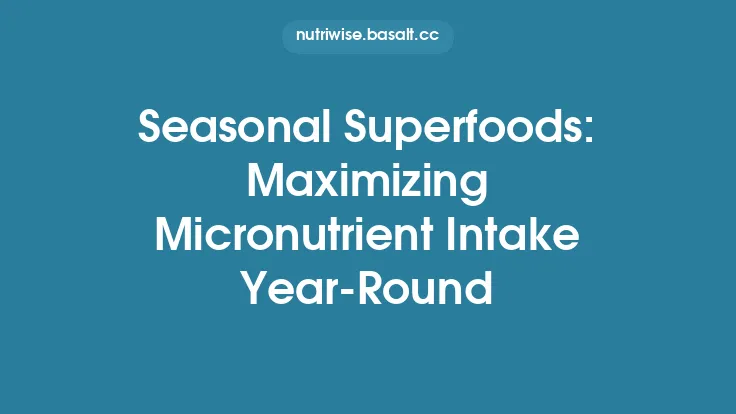The changing calendar brings a natural shift in the foods that are at their peak, and with those shifts comes an opportunity to fine‑tune the micronutrient profile of our diets. While macronutrients—carbohydrates, proteins, and fats—often dominate the conversation, the vitamins we obtain from seasonal produce play an equally vital role in supporting cellular function, immune resilience, and overall well‑being. By aligning vitamin intake with the produce that naturally ripens each quarter, we can maximize bioavailability, reduce the need for supplementation, and enjoy a more varied palate.
Understanding Seasonal Vitamin Availability
The Science of Plant Metabolism
Plants synthesize vitamins as part of their own defense mechanisms and growth cycles. Light intensity, temperature fluctuations, and soil composition influence the concentration of specific micronutrients. For example:
| Seasonal Factor | Typical Vitamin Boost |
|---|---|
| Longer daylight (summer) | Higher levels of vitamin C and carotenoids |
| Cooler nights (autumn) | Increased anthocyanins (precursors to vitamin K) |
| Frost exposure (winter) | Elevated vitamin A precursors in certain greens |
| Rapid growth phase (spring) | Surge in B‑vitamin synthesis, especially folate |
Understanding these patterns helps us anticipate which vitamins will be most abundant in the market at any given time.
Bioavailability Matters
Not all vitamin content translates directly into what our bodies can absorb. Factors that affect bioavailability include:
- Food matrix – Fat‑soluble vitamins (A, D, E, K) are better absorbed when consumed with dietary fats.
- Cooking method – Light steaming preserves water‑soluble vitamins (C, B‑complex) better than boiling, which can leach them into the cooking water.
- Synergistic compounds – Vitamin C enhances iron absorption; certain polyphenols can inhibit or promote vitamin uptake.
When planning a seasonal menu, it is useful to pair foods in ways that support these interactions.
Spring: A Surge of Folate and Vitamin C
Key Vitamins
- Folate (Vitamin B9) – Crucial for DNA synthesis, red blood cell formation, and fetal development.
- Vitamin C (Ascorbic Acid) – Powerful antioxidant, supports collagen synthesis, and improves iron absorption.
Seasonal Produce Highlights
| Produce | Approx. Vitamin Content (per 100 g) | Notable Compounds |
|---|---|---|
| Asparagus | Folate: 52 µg; Vitamin C: 5 mg | Inulin (prebiotic fiber) |
| Strawberries | Vitamin C: 59 mg; Folate: 24 µg | Anthocyanins |
| Spinach (young leaves) | Folate: 194 µg; Vitamin C: 28 mg | Lutein, beta‑carotene |
| Peas (fresh) | Folate: 65 µg; Vitamin C: 40 mg | Resistant starch |
Practical Tips
- Raw or lightly cooked: To preserve folate, consume spinach and peas raw in salads or quickly sautéed.
- Vitamin C pairing: Add a squeeze of lemon juice to asparagus or a handful of strawberries to a leafy green salad to boost iron absorption from plant sources.
- Storage: Keep berries in a single layer on a paper towel in the refrigerator to minimize moisture loss and preserve vitamin C.
Summer: Maximizing Vitamin A and Vitamin E
Key Vitamins
- Vitamin A (Retinol & Provitamin A Carotenoids) – Essential for vision, immune function, and skin health.
- Vitamin E (Tocopherols) – Protects cell membranes from oxidative damage and supports immune cells.
Seasonal Produce Highlights
| Produce | Approx. Vitamin Content (per 100 g) | Notable Compounds |
|---|---|---|
| Sweet corn | Provitamin A: 310 µg RAE; Vitamin E: 0.1 mg | Zeaxanthin |
| Bell peppers (red) | Vitamin A: 313 µg RAE; Vitamin C: 80 mg | Capsanthin |
| Mango | Provitamin A: 54 µg RAE; Vitamin E: 0.9 mg | Mangiferin |
| Zucchini (with skin) | Vitamin A: 200 µg RAE; Vitamin E: 0.2 mg | Lutein |
Practical Tips
- Fat‑enhanced preparation: Sauté bell peppers or corn with a drizzle of olive oil to improve absorption of carotenoids.
- Raw vs. cooked: Carotenoids become more bioavailable after mild heat; steaming zucchini for 3–5 minutes is sufficient.
- Avoid over‑cooking: Prolonged high heat can degrade vitamin E; keep cooking times short and use gentle methods like stir‑frying.
Autumn: Embracing Vitamin K and B‑Complex
Key Vitamins
- Vitamin K1 (Phylloquinone) – Critical for blood clotting and bone metabolism.
- Vitamin B6 (Pyridoxine) – Involved in neurotransmitter synthesis and amino‑acid metabolism.
- Vitamin B2 (Riboflavin) – Supports energy production and antioxidant defenses.
Seasonal Produce Highlights
| Produce | Approx. Vitamin Content (per 100 g) | Notable Compounds |
|---|---|---|
| Kale (curly) | Vitamin K: 817 µg; Vitamin C: 120 mg | Sulforaphane |
| Brussels sprouts | Vitamin K: 177 µg; Vitamin B6: 0.2 mg | Glucosinolates |
| Butternut squash | Vitamin A: 850 µg RAE; Vitamin B6: 0.2 mg | Beta‑carotene |
| Apples (with skin) | Vitamin K: 2.2 µg; Vitamin B2: 0.02 mg | Quercetin |
Practical Tips
- Preserve vitamin K: Lightly steam kale and Brussels sprouts; avoid boiling to prevent leaching of water‑soluble B‑vitamins.
- Combine with healthy fats: Drizzle roasted butternut squash with a nut oil to aid absorption of fat‑soluble vitamin A while maintaining B‑vitamin integrity.
- Storage: Keep apples in a cool, humid environment (e.g., a crisper drawer) to slow vitamin loss.
Winter: Harnessing Vitamin D and Vitamin C from Limited Fresh Produce
Key Vitamins
- Vitamin D (Calciferol) – Though primarily synthesized via sunlight, certain winter foods provide modest amounts and can complement limited sun exposure.
- Vitamin C – Remains essential for immune support during colder months when viral infections are more prevalent.
Seasonal Produce Highlights
| Produce | Approx. Vitamin Content (per 100 g) | Notable Compounds |
|---|---|---|
| Citrus fruits (oranges, grapefruits) | Vitamin C: 53 mg; Folate: 30 µg | Hesperidin |
| Kale (hardy varieties) | Vitamin C: 120 mg; Vitamin K: 817 µg | Kaempferol |
| Parsnips | Vitamin C: 17 mg; Vitamin B6: 0.2 mg | Inulin |
| Fortified plant milks (e.g., soy, oat) | Vitamin D: 2.5 µg (100 IU) per cup | Calcium, vitamin B12 |
Practical Tips
- Maximize vitamin C retention: Use raw citrus in dressings or add zest at the end of cooking to avoid heat degradation.
- Vitamin D synergy: Pair fortified plant milks with a source of healthy fat (e.g., a handful of nuts) to improve absorption of the fat‑soluble vitamin D.
- Cold‑preserve: Store citrus fruits at room temperature for a few days to maintain flavor, then move to refrigeration for longer storage.
Integrating Seasonal Micronutrients into a Balanced Diet
Building a Micronutrient‑Rich Plate
- Base layer – Greens: Choose a seasonal leafy vegetable (e.g., spinach in spring, kale in winter). This supplies a spectrum of vitamins A, C, K, and folate.
- Colorful accent – Fruit or veg: Add a brightly colored fruit or vegetable that aligns with the season’s vitamin peak (e.g., strawberries for vitamin C in spring, red bell pepper for vitamin A in summer).
- Protein partner – Plant or animal: Pair with a protein source that does not compete for the same micronutrient pathways (e.g., legumes in spring for B‑vitamins, fish in winter for vitamin D).
- Healthy fat drizzle – Oil or nuts: Finish with a modest amount of oil (olive, walnut) or nuts to facilitate absorption of fat‑soluble vitamins.
Sample Weekly Rotation
| Day | Season | Primary Vitamin Focus | Key Produce |
|---|---|---|---|
| Mon | Spring | Folate & Vitamin C | Asparagus + strawberries |
| Tue | Spring | Vitamin C | Peas + orange segments |
| Wed | Summer | Vitamin A & E | Red bell pepper + corn |
| Thu | Summer | Vitamin A | Mango + zucchini |
| Fri | Autumn | Vitamin K & B‑6 | Kale + Brussels sprouts |
| Sat | Autumn | Vitamin B‑complex | Butternut squash + apples |
| Sun | Winter | Vitamin C & D | Citrus salad + fortified oat milk |
Rotating the focus each day ensures that no single vitamin is over‑ or under‑represented, while also providing culinary variety.
Monitoring and Adjusting Intake
Signs of Micronutrient Imbalance
| Vitamin | Deficiency Indicators | Excess Risks |
|---|---|---|
| Vitamin A (beta‑carotene) | Night blindness, dry skin | Hypervitaminosis A (rare from food alone) |
| Vitamin C | Fatigue, gum bleeding | Diarrhea (high supplemental doses) |
| Vitamin K | Easy bruising, prolonged clotting | Interference with anticoagulant medication |
| Vitamin D | Bone pain, muscle weakness | Hypercalcemia (mostly from over‑supplementation) |
| Folate | Megaloblastic anemia, neural tube defects (pregnancy) | Masking B12 deficiency |
If persistent symptoms arise, a targeted blood test can pinpoint specific deficiencies. However, most healthy adults can correct minor gaps through strategic seasonal food choices.
When to Consider Supplementation
- Limited sun exposure (high latitude, indoor lifestyle) → Vitamin D supplement may be warranted.
- Pregnancy → Folate supplementation is standard, even with abundant seasonal greens.
- Specific medical conditions (e.g., malabsorption syndromes) → Tailored micronutrient formulas under professional guidance.
Conclusion
Seasonal produce is more than a culinary curiosity; it is a dynamic source of the vitamins that sustain our bodies year‑round. By recognizing which micronutrients naturally peak during each season, we can craft meals that align with the plant’s own nutritional timeline, enhancing bioavailability and supporting optimal health. The approach is simple yet powerful: let the calendar guide your plate, pair foods to boost absorption, and stay attuned to your body’s signals. In doing so, you turn the rhythm of the seasons into a reliable, delicious strategy for lifelong micronutrient balance.





